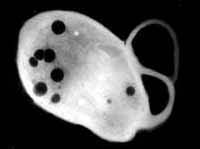Organelle’s discovery challenges theory, could alter approach to disease treatment

Acidocalcisomes (the black spheres) as viewed in a trypanosome, a family of parasites that cause African sleeping sickness, Chagas disease and leishmaniasis and the first organisms where Docampo found this organelle. The cell is approximately 10 microns long and 4 microns wide. Courtesy of Kildare Miranda
Researchers looking inside a pathogenic soil bacterium have found an organelle, a subcellular pouch, existing independently from the plasma membrane. The discovery within a prokaryotic organism challenges the theory on the origin of eukaryotic organelles and suggests a targeted approach to killing many disease-causing organisms.
“The organelle we found in the bacterium Agrobacterium tumefaciens is practically identical to the organelle called acidocalcisome in unicellular eukaryotes,” said Roberto Docampo, a professor of veterinary pathobiology in the College of Veterinary Medicine at the University of Illinois at Urbana-Champaign.
Docampo began researching these organelles in 1994. He soon determined that a tiny granule in yeast, fungi and bacteria, thought to be for storage, was a fully operational organelle containing pyrophosphatase, a pump-like enzyme that allows proton transport. He named it an acidocalcisome for its acidic and calcium components. In 2000, he reported its existence in Plasmodium berghei, a malaria-causing eukaryotic parasite.
The newest discovery appeared in a paper published online this month by the Journal of Biological Chemistry. The paper, by Docampo and colleagues at the Center for Zoonoses Research and Laboratory of Molecular Parasitology at Illinois, will be published in a later print edition of the journal.
Agrobacterium tumefaciens is a prokaryote, a unicellular organism lacking membrane-bound nuclei. It causes crown gall disease in many broad-leaved plants but also is a favored tool for plant breeding because of its model system of DNA transfer into the hosts it invades. Samples were provided to Docampo’s team by biotechnology researcher Stephen K. Farrand, a professor of microbiology and crop sciences at Illinois.
Bacteria and other prokaryotes generally lack an endomembrane system.
Thus bacteria are presumed to lack compartments such as organelles not somehow linked to the plasma membrane ringing the organisms.
“What we describe is a discrete organelle independent of the plasma membrane,” Docampo said. “It has a proton pump in its membrane, which is used to maintain its interior acidic content. This has never been described before in a bacterium.”
The existence of discrete organelles is a defining component of unicellular eukaryotes, which have membrane-bound nuclei and specialized structures in their cell boundaries. The evolution of eukaryotic organelles “is a matter of extensive debate,” Docampo said. The principle of endosymbiosis says that as microorganisms engulfed others, then new, membrane-surrounded organelles emerged in eukaryotes.
“It appears that this organelle has been conserved in evolution from prokaryotes to eukaryotes, since it is present in both. This argues against the belief that all eukaryotic organelles were formed when early eukaryotes swallowed prokaryotes,” he said.
Using transmission electron and immunoelectron microscopy and X-ray microanalysis on the bacterium, researchers got a highly magnified and illuminated view.
They applied a fluorescent dye into the suspected organelle. They saw a membrane around it. The dye stained areas only within it, not in the cytosol. Serum containing antibodies to peptides related to pyrophosphatase unveiled this pump-like enzyme, and other staining techniques revealed high levels of polyphosphate only in the organelle.
Many parasites such as those that cause malaria, African sleeping sickness and toxoplasmosis and bacteria that contain these acidocalcisome organelles are pathogens.
Some pharmaceutical approaches have targeted pyrophosphate-related enzymes, Docampo said. “Our suggestion is that if drugs specifically targeted these organelles, you may be able to kill the entire organisms.”
In addition to Docampo, other Illinois researchers were Manfredo Seufferheld, Mauricio C.F. Vieira, Felix A. Ruiz, Claudia O. Rodrigues and Silvia N.J. Moreno. The National Institutes of Health funded the research through a grant to Docampo.
Media Contact
More Information:
http://www.news.uiuc.edu/scitips/03/0617organelle.htmlAll latest news from the category: Life Sciences and Chemistry
Articles and reports from the Life Sciences and chemistry area deal with applied and basic research into modern biology, chemistry and human medicine.
Valuable information can be found on a range of life sciences fields including bacteriology, biochemistry, bionics, bioinformatics, biophysics, biotechnology, genetics, geobotany, human biology, marine biology, microbiology, molecular biology, cellular biology, zoology, bioinorganic chemistry, microchemistry and environmental chemistry.
Newest articles

An Endless Loop: How Some Bacteria Evolve Along With the Seasons
The longest natural metagenome time series ever collected, with microbes, reveals a startling evolutionary pattern on repeat. A Microbial “Groundhog Year” in Lake Mendota Like Bill Murray in the movie…

Witness Groundbreaking Research on Achilles Tendon Recovery
Achilles tendon injuries are common but challenging to monitor during recovery due to the limitations of current imaging techniques. Researchers, led by Associate Professor Zeng Nan from the International Graduate…

Why Prevention Is Better Than Cure—A Novel Approach to Infectious Disease Outbreaks
Researchers have come up with a new way to identify more infectious variants of viruses or bacteria that start spreading in humans – including those causing flu, COVID, whooping cough…



